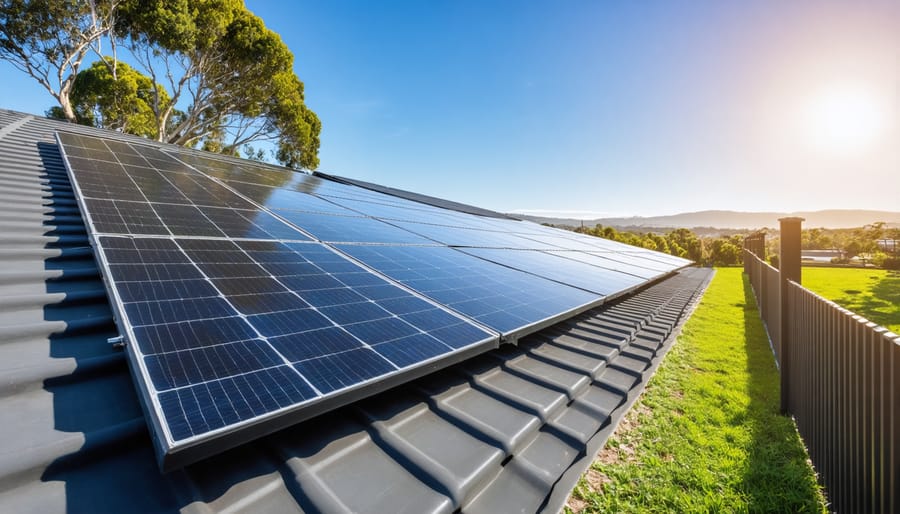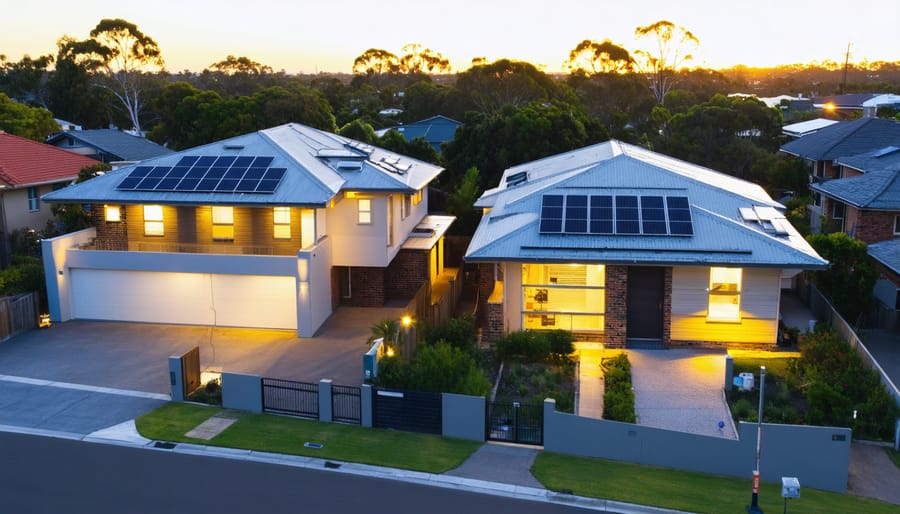Australia’s energy grid is undergoing its most dramatic transformation in a century, and blockchain technology is emerging as an unexpected champion in this renewable revolution. Imagine a system where your rooftop solar panels automatically sell excess energy to your neighbour, where every electron flowing through the grid is tracked with unprecedented transparency, and where cyber attacks on critical infrastructure become virtually impossible. This isn’t science fiction—it’s already happening in Australian communities from Perth to Sydney.
Blockchain, the technology that powers cryptocurrencies, is proving itself as a powerful tool for managing decentralised energy systems. It creates an immutable digital ledger that records every energy transaction, enabling peer-to-peer trading without middlemen, securing grid infrastructure against tampering, and making renewable energy certificates impossible to forge or double-count. For a nation racing toward its renewable energy targets, these capabilities couldn’t be more timely.
The beauty of blockchain in energy lies in its democratic potential. It empowers households and businesses to become active participants in the energy market rather than passive consumers. Small-scale solar generators, battery storage operators, and even bioenergy producers can now interact directly with the grid, creating microgrids that are resilient, efficient, and genuinely sustainable.
Yet understanding how this technology works—and separating genuine applications from hype—remains crucial for anyone invested in Australia’s clean energy future.
What Blockchain Actually Means for Energy (No Tech Jargon Required)
The Trust Problem Blockchain Solves
Imagine you’ve installed solar panels on your Brisbane home and you’re generating more electricity than you need on a sunny afternoon. Your neighbour, meanwhile, is running their air conditioner but doesn’t have solar. Traditionally, you’d sell your excess power back to the grid through your retailer, who’d then sell it to your neighbour—with each middleman taking a cut and adding complexity.
Blockchain technology removes this trust barrier by creating a transparent, tamper-proof digital ledger that both parties can verify. Think of it as a digital handshake that automatically records who generated how much energy, who consumed it, and at what price—without needing a third party to validate the transaction.
This matters because energy transactions require absolute certainty: Did the power actually flow? Was payment received? Who owns the renewable energy credits? Blockchain answers these questions automatically through its distributed network, where multiple computers verify each transaction. Once recorded, the information cannot be altered, creating trust through transparency rather than through corporate intermediaries. For everyday Aussies embracing renewable energy, this means simpler, faster, and potentially cheaper energy sharing within local communities.
Why Energy Companies Are Taking Notice
Australia’s energy sector is experiencing a profound transformation, and blockchain technology has emerged as a game-changer for managing our renewable energy future. Traditional energy grids were designed for one-way power flow from centralised generators to consumers, but today’s reality is vastly different. With rooftop solar panels sprouting across Australian suburbs and communities embracing wind and bioenergy projects, we’re creating thousands of mini power stations that need sophisticated coordination.
Energy companies are turning to blockchain because it offers something revolutionary: a transparent, secure way to track and trade renewable energy in real-time. Think of it as a digital ledger that automatically records every kilowatt-hour generated, consumed, or traded across the network. This becomes particularly valuable when managing distributed renewable sources that generate power intermittently.
The technology integrates seamlessly with smart grid technology, enabling automated peer-to-peer energy trading and instant verification of renewable energy certificates. For energy companies, this means reduced administrative costs, faster transactions, and improved grid stability. More importantly, it creates opportunities for everyday Australians to become active participants in the energy market, selling excess solar power directly to neighbours or businesses, making renewable energy not just environmentally smart but economically rewarding.
Trading Solar Power with Your Neighbour: Blockchain’s Most Exciting Promise

Real Projects Already Happening in Australia
Australia isn’t just talking about blockchain in energy—we’re actually doing it. Several groundbreaking projects are already demonstrating how this technology can transform our energy landscape.
**Power Ledger** leads the charge as one of the world’s most successful blockchain energy companies, born right here in Perth. Their platform has facilitated peer-to-peer energy trading trials across multiple Australian locations, including a landmark project in Fremantle where residents traded solar energy directly with their neighbours. The results? Participants reported greater control over their energy choices and better returns on their solar investments.
In Western Australia, **Powertracer** is using blockchain to track renewable energy certificates, giving businesses and households absolute certainty about the green credentials of their electricity. This transparency matters enormously for organizations committed to genuine sustainability.
Melbourne’s **community energy initiatives** have embraced blockchain to create local energy marketplaces, where apartment buildings with solar panels can sell excess power to nearby properties. These projects prove that blockchain isn’t some distant future concept—it’s helping Aussie communities become energy independent today.
The **CSIRO** has also run successful trials exploring how blockchain can support renewable energy integration in remote communities, addressing the unique challenges of Australia’s vast landscape.
These real-world examples demonstrate that blockchain technology is moving beyond hype. Australian innovators are proving that secure, transparent, decentralized energy systems aren’t just possible—they’re happening now, making our transition to renewable energy smoother and more equitable for everyone.
The Money-Saving Potential for Households
For Australian households grappling with rising electricity costs, blockchain-enabled energy trading presents a fair dinkum opportunity to turn solar panels into genuine money-makers. Traditional feed-in tariffs often pay households just 5-10 cents per kilowatt-hour for exported solar power, while buying that same energy back costs 25-35 cents. It’s hardly a fair go for those who’ve invested in rooftop solar.
Blockchain-based peer-to-peer trading flips this equation. By enabling direct sales to neighbours, households can potentially earn 15-20 cents per kilowatt-hour for their excess solar—double or triple the standard rate. Meanwhile, buyers access renewable energy at prices below retail rates, creating win-win transactions that keep money circulating within local communities rather than flowing to large retailers.
The financial impact compounds over time. A typical Sydney household with a 5-kilowatt solar system might export 15-20 kilowatt-hours daily during peak production. At improved rates through local trading, that’s an additional $300-600 annually compared to standard feed-in tariffs—enough to offset connection fees or accelerate payback periods on solar investments.
Beyond direct trading benefits, blockchain platforms provide transparent real-time data about energy consumption patterns, empowering households to identify wasteful appliances and shift usage to cheaper periods. This combination of better solar returns and smarter consumption habits could realistically trim hundreds of dollars from annual energy bills while supporting Australia’s renewable energy future.
Making the Grid More Secure and Resilient

Preventing Cyber Attacks on Energy Infrastructure
Australia’s energy infrastructure faces increasing cyber threats as our grid becomes more digitised and interconnected. Traditional centralised systems create single points of vulnerability—hack one database, and you could potentially disrupt power to thousands of homes or manipulate critical data.
Blockchain technology offers a robust defence through its decentralised architecture. Rather than storing sensitive grid information in one location, blockchain distributes it across multiple nodes, making it extraordinarily difficult for hackers to manipulate. Each transaction or data entry is cryptographically sealed and linked to previous entries, creating an immutable record that flags any tampering attempts immediately.
For Australia’s renewable energy sector, this protection is vital. As we integrate more solar farms, wind installations, and bioenergy plants into the grid, grid security becomes increasingly complex. Blockchain can safeguard everything from smart meter readings to energy trading platforms, ensuring the data driving our clean energy transition remains trustworthy and secure.
Several Australian energy providers are already piloting blockchain-based security systems, recognising that protecting our energy infrastructure isn’t just about preventing blackouts—it’s about maintaining public confidence in our renewable energy future. As cyber threats evolve, blockchain’s adaptive security features position it as an essential tool for safeguarding Australia’s green grid transformation.
Better Response During Emergencies
When the lights go out, every second counts. Blockchain technology is proving to be a game-changer for emergency response in Australia’s energy sector, enabling communities to bounce back faster when disaster strikes.
During severe weather events—think cyclones in Queensland or bushfires across the eastern states—blockchain-enabled systems can automatically reroute power, coordinate microgrids during disasters, and maintain essential services when the main grid fails. Rather than waiting for centralized commands, these smart systems respond in real-time, keeping hospitals, emergency services, and critical infrastructure running.
The beauty lies in blockchain’s ability to create a transparent, tamper-proof record of energy flows. Emergency coordinators can instantly see which areas need support, where backup power is available, and how to best allocate resources. Communities with rooftop solar and battery storage become resilient energy hubs, automatically sharing excess power with neighbours through blockchain-verified transactions.
In South Australia, trials have demonstrated how these systems can maintain power to entire neighbourhoods even when surrounding areas are dark. It’s not just about keeping the lights on—it’s about building stronger, more self-reliant communities that can weather any storm. This technology transforms our energy infrastructure from vulnerable to virtually unshakeable.
Tracking Renewable Energy Certificates and Carbon Credits
Why This Matters for Bioenergy Producers
For biomass energy facilities across Australia, blockchain technology offers a powerful solution to one of the industry’s biggest challenges: proving your green credentials beyond doubt.
Imagine being able to trace every tonne of agricultural waste from a Queensland sugarcane farm right through to the renewable energy it generates, with every transaction recorded permanently and transparently. That’s the promise blockchain brings to bioenergy producers. This technology creates an immutable digital trail that verifies sustainable sourcing practices, demonstrating that biomass feedstock truly comes from waste materials rather than purpose-grown crops competing with food production.
For facilities claiming carbon neutrality, blockchain can automatically record and verify carbon offset calculations at every stage of production. When coupled with IoT sensors, it can track emissions data in real-time, creating trustworthy records that satisfy even the most rigorous regulatory requirements and sceptical stakeholders.
This transparency builds confidence with investors, qualifies producers for premium green energy certificates, and opens doors to international markets where provenance matters. Several Australian facilities are already piloting these systems, discovering that blockchain doesn’t just verify their sustainability claims—it transforms them into a competitive advantage that’s impossible to fake.
Creating Trust in Green Energy Claims
For years, renewable energy buyers have faced a genuine challenge: how do you really know your electricity came from a solar farm rather than a coal-fired power station? Traditional renewable energy certificates can be traded multiple times, creating confusion about who actually gets to claim the environmental benefit.
Blockchain technology is transforming this uncertainty into confidence. By recording every unit of renewable energy generated on an unchangeable digital ledger, blockchain creates an unbreakable chain of custody from the wind turbine or solar panel right through to your power socket. It’s like having a birth certificate for every kilowatt-hour of clean energy.
This verification matters enormously for Australian businesses committed to genuine sustainability. Companies can now prove to stakeholders that their renewable energy claims are fair dinkum, not just clever marketing. For households, it means trusting that your premium renewable energy tariff is delivering exactly what it promises.
Several Australian energy retailers are already implementing blockchain-verified green energy products, allowing customers to trace their electricity back to specific renewable generators. This transparency doesn’t just build trust—it rewards genuine renewable energy producers and accelerates Australia’s clean energy transition by connecting conscious consumers directly with sustainable power sources.
The Challenges We Still Need to Overcome
Regulation and Policy Gaps in Australia
Australia’s blockchain energy revolution hinges on clear regulatory frameworks that currently don’t exist. While innovative projects are already demonstrating blockchain’s potential for peer-to-peer energy trading and grid management, they’re operating in a regulatory grey zone that’s holding back wider adoption.
The Australian Energy Market Commission and state-based energy regulators need to establish guidelines around how blockchain-recorded energy transactions fit within existing market structures. This includes clarifying liability issues, consumer protections, and how these digital exchanges interact with traditional energy retailers and networks.
Success stories from Perth’s Power Ledger trials and Melbourne’s microgrid projects show what’s possible when regulatory sandboxes allow experimentation. However, we need permanent policy solutions, not temporary testing grounds.
Government action should focus on three priorities: creating standardised protocols for blockchain energy systems, updating the National Electricity Rules to accommodate peer-to-peer trading, and establishing cybersecurity standards for blockchain platforms managing critical infrastructure.
The good news? Energy Ministers have recognised blockchain’s potential in national strategy discussions. With coordinated federal and state efforts, Australia could become a global leader in blockchain-enabled renewable energy systems, making clean energy trading accessible for all Australians while strengthening our grid security.
Technical Hurdles and Energy Use Concerns
Here’s a fair dinkum challenge: blockchain technology, often touted as a solution for renewable energy management, has historically been an energy guzzler itself. Traditional blockchain systems like Bitcoin use “proof-of-work” mechanisms that require massive computing power—consuming more electricity annually than some entire countries. The irony isn’t lost on environmental advocates: how can we promote a technology for sustainable energy grids when it’s burning through megawatts?
The good news? The blockchain world is evolving rapidly. Newer “proof-of-stake” alternatives slash energy consumption by up to 99.95%, making them genuinely viable for green applications. Ethereum’s recent transition demonstrates this shift is possible and practical. Australian projects are increasingly adopting these efficient protocols, ensuring blockchain’s role in our renewable energy future doesn’t contradict our climate goals. While technical hurdles remain—including scaling solutions and interoperability between systems—the trajectory is promising. Innovation is transforming blockchain from energy liability to legitimate sustainability tool, proving that technology can adapt when environmental imperatives demand it.
What This Means for Australia’s Sustainable Energy Future
Australia stands at the threshold of an energy revolution, and blockchain technology is emerging as the digital backbone that could unite our diverse renewable resources into a seamlessly integrated system. Imagine a future where your rooftop solar panels, neighbourhood bioenergy plant, and nearby wind farm all communicate through a secure blockchain network, automatically optimising power flow and trading excess energy in real-time.
This isn’t science fiction—it’s the practical next step in our clean energy journey. Blockchain can coordinate the intermittent nature of solar and wind with the steady, reliable output of bioenergy facilities, creating a balanced grid that’s both sustainable and dependable. When the sun sets on Perth or the wind dies down in Tasmania, bioenergy plants can ramp up production, with blockchain automatically recording and settling these complex transactions in seconds rather than days.
The integration extends to battery storage systems too, where blockchain can track when batteries charge from excess solar during the day and discharge during evening peaks, ensuring every kilowatt-hour is accounted for and fairly compensated. This creates genuine energy democracy—where farmers generating bioenergy from crop waste, suburban households with solar panels, and large wind farms all participate in the same transparent marketplace.
The beauty of this blockchain-enabled system lies in its ability to reward sustainable choices. Communities that invest in local bioenergy projects or install solar panels can see immediate financial returns through peer-to-peer trading, accelerating Australia’s transition away from fossil fuels while building energy resilience in regional areas. This integrated approach transforms our renewable assets from isolated installations into a collaborative, intelligent network working toward a common goal: a cleaner, more sustainable Australia.

Australia stands at an exciting crossroads where innovative blockchain technology meets our growing commitment to renewable energy. Throughout this exploration, we’ve seen how blockchain isn’t just abstract tech—it’s a practical tool already helping Australian communities trade solar energy peer-to-peer, secure our electricity grids, and track renewable energy certificates with unprecedented transparency. From Power Ledger’s success stories in Perth to trials across regional communities, the evidence shows we’re not just talking about future possibilities; we’re witnessing real change today.
The journey toward a decentralized, sustainable energy future won’t happen overnight, and it won’t happen without your involvement. Whether you’re a homeowner considering solar panels, a business leader evaluating energy strategies, or simply someone who cares about Australia’s environmental future, now’s the time to engage. Stay informed about blockchain energy projects in your area, support pilot programs when opportunities arise, and have conversations with your energy providers about innovative solutions. Ask questions, share knowledge with your community, and consider how these technologies might fit into your own energy choices.
The combination of Australian ingenuity, abundant renewable resources, and blockchain technology creates genuine reason for optimism. By embracing these innovations today, we’re not just reducing emissions—we’re building a fairer, more resilient energy system that empowers every Australian to participate in our clean energy future. The technology exists; what matters now is collective action and commitment to making it work.

